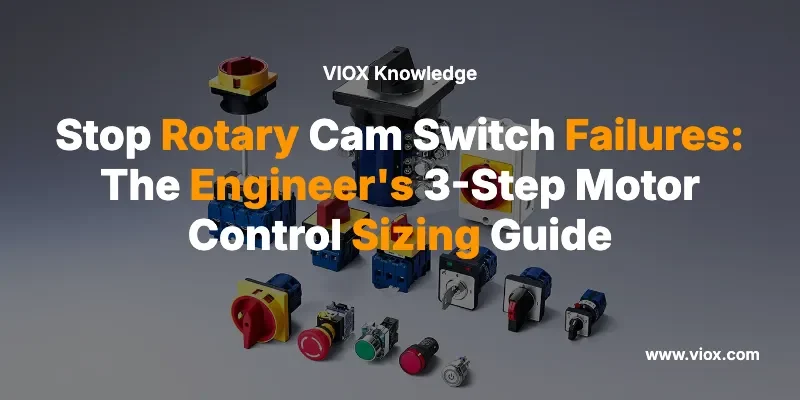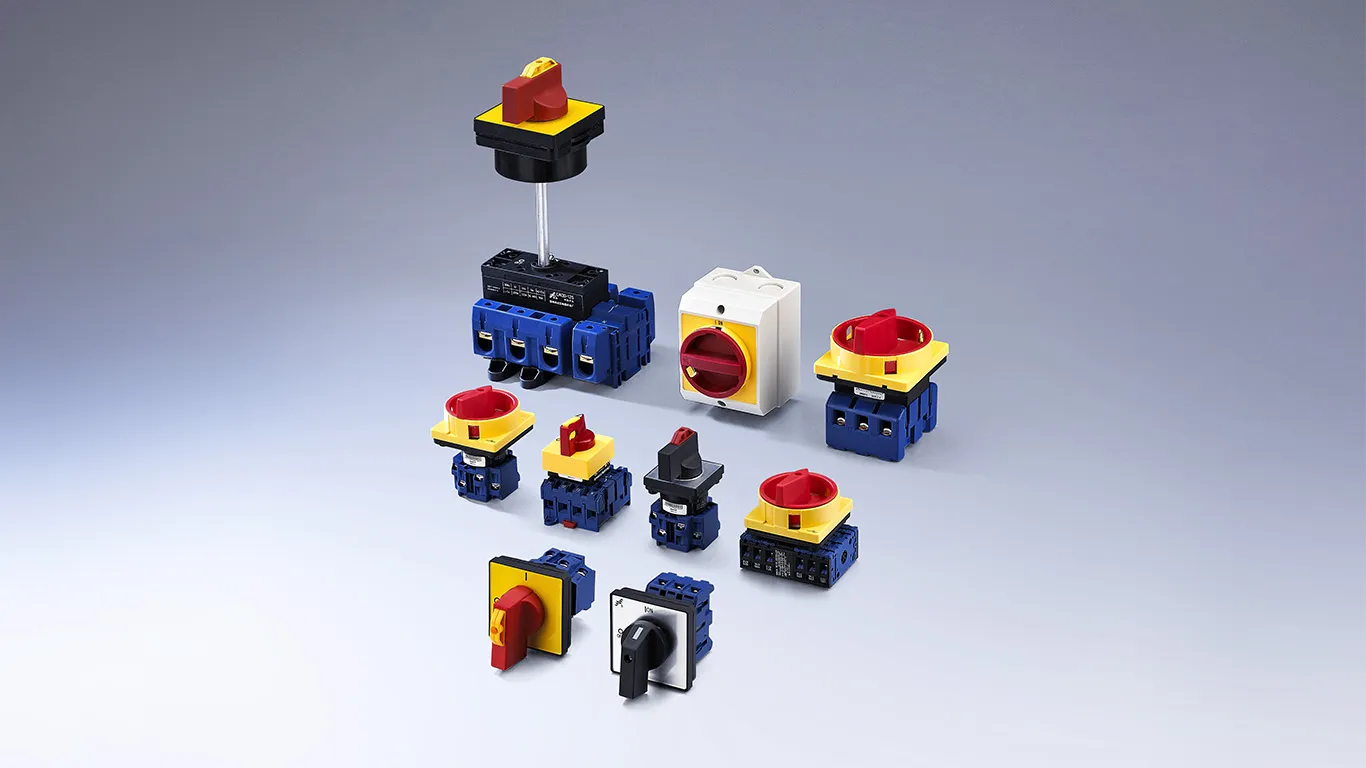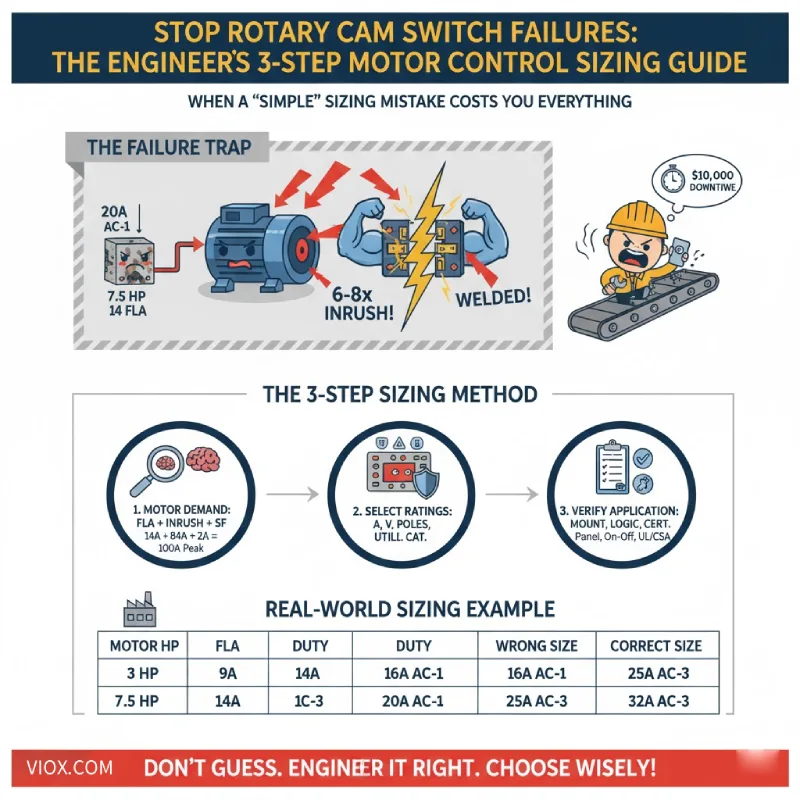When a “Simple” Sizing Mistake Costs You Everything
You’re finalizing the control panel design for a new production line. The mechanical team specified a 7.5 HP three-phase motor for the main conveyor, and you’ve meticulously calculated wire sizes, selected the overload relay, and routed everything according to code. The rotary cam switch for motor control? You picked one rated for 20 amps—after all, the motor’s nameplate shows 14 FLA. That should be plenty of headroom, right?
Three months after commissioning, you get the call no engineer wants to hear: the conveyor won’t stop. The rotary cam switch contacts have welded together, the motor is running uncontrollably, and the entire production line is shut down for emergency maintenance. The post-mortem reveals charred switch contacts and a replacement cost that’s 10x the original component price—not counting the downtime.
So what went wrong? And more importantly, how do you size a rotary cam switch that won’t fail when it matters most?
The answer isn’t as simple as “match the amp rating to the motor.” In this guide, you’ll learn the three-step method that experienced engineers use to size rotary cam switches for bulletproof motor control—accounting for the electrical realities that datasheets don’t always make obvious.
Why “Amp-Rated” Doesn’t Mean “Motor-Rated”
Here’s the brutal truth that causes most rotary cam switch failures: a switch doesn’t just pass current—it makes and breaks current under load. And when that load is a motor, the electrical stress is brutal.
Consider what happens the moment you close a switch on a motor circuit. That “14 amp” motor you calculated? During direct-on-line starting, it draws 6 to 8 times its full load current for several seconds as the rotor accelerates from standstill. Your switch contacts must close against this inrush without welding, and later open against the motor’s back-EMF without arcing catastrophically.
This is why switches carry utilization category ratings like AC-1, AC-3, and AC-4:
- AC-1: Resistive loads (heaters). Easy duty—minimal inrush, no back-EMF.
- AC-3: Squirrel-cage motor starting and running. Handles 6x inrush on closing, breaks at running current.
- AC-4: Severe duty—motor plugging, reversing, jogging. Makes and breaks at up to 6x FLA.
A switch rated “20A” for AC-1 duty might only handle a 5 HP motor on AC-3 duty. The nominal amperage alone tells you nothing about motor control capability.
กุญแจ Takeaway: The switch contacts, arc suppression design, and mechanical durability all differ between a “20A general purpose” switch and a “20A AC-3 motor control” switch. Always verify the utilization category before selecting.
The 3-Step สวิตช์ลูกเบี้ยวหมุน Sizing Method
Follow this systematic process to specify a switch that handles the real-world electrical stress of motor control—not just the theoretical nameplate numbers.
Step 1: Calculate Your Motor’s True Electrical Demand
Don’t just copy the FLA from the motor nameplate and call it done. You need to understand your motor’s complete electrical profile:
1.1 Start with Full Load Amperage (FLA)
Find this on the motor nameplate at its rated voltage. For example:
- 3 HP at 208V = ~9A
- 7.5 HP at 415V = 10-14A
- 15 HP at 480V = 20-22A
1.2 Account for Starting Method
How you start the motor dramatically affects switch stress:
- Direct-On-Line (DOL): Full inrush current hits the switch. Most demanding on closing.
- Star-Delta: Lower inrush, but two switching operations per start.
- Soft Starter/VFD: Controlled ramp-up, but you still need to switch the full running current.
1.3 Consider Service Factor
If your motor runs continuously or near maximum load, apply a service factor. Many engineers use 1.15x to 1.25x FLA as the design current.
มืออาชีพเคล็ดลับ: For a 7.5 HP motor at 415V drawing 14A FLA with DOL starting, your switch must handle 14A continuous plus 80-100A inrush for several seconds. This immediately tells you a 16A switch is undersized—you need at least 25A rated for AC-3 duty.
Step 2: Select the Switch with the Correct Ratings
Now match your motor’s profile to a switch that can handle it. You’re checking four critical specifications:
2.1 Current Rating (Always Round Up)
Select a switch with a current rating equal to or greater than your motor’s maximum running current—with margin.
| Motor HP | Voltage | Full Load Amps | Suggested Switch Amperage |
|---|---|---|---|
| 3 HP | 208 V | ~9A | 16 A |
| 7.5 HP | 415 V | ~10-14A | 25 A |
| 15 HP | 480 V | ~20-22A | 25-32 A |
กุญแจ Takeaway: Round up to the nearest standard switch size. If your motor draws 22A, choose 25A or 32A—never 20A. This margin protects against voltage sag during starting and provides thermal headroom for continuous duty.
2.2 Voltage Rating (Meet or Exceed)
The switch voltage rating must equal or exceed your motor supply voltage:
- 400V motor → minimum 400V switch
- 480V motor → 480V or 600V switch
- Never use a 400V switch on a 480V circuit
2.3 Pole Configuration
Match poles to your motor phase configuration:
- Single-phase motors: 2-pole switch (both line conductors switched)
- Three-phase motors: 3-pole switch (all three phases switched simultaneously)
Critical: Don’t use a single-pole switch to control a three-phase motor by switching only one phase. This creates phase unbalance and can destroy the motor.
2.4 Utilization Category (The Hidden Specification)
This is where engineers get burned. Verify the switch is rated for your specific duty:
- Standard DOL starting/stopping: AC-3 minimum
- Reversing, plugging, or multi-speed control: AC-4 required
- On-off switching only (no starting duty): AC-3 is sufficient
A switch rated “25A AC-1” might only handle 12A on AC-3 duty. Always check the manufacturer’s motor control ratings table—don’t assume the nominal rating applies.
Step 3: Verify Application-Specific Requirements
You’ve got the electrical ratings right. Now confirm the physical and environmental specifications:
3.1 Mounting and Enclosure
- Panel mounting: Front-of-door with operator handle
- DIN rail: Space-saving for dense control panels
- Enclosed: IP65/NEMA 4 for dusty or washdown environments
3.2 Control Logic and Positions
- 2-position (On-Off): Simple start/stop
- 3-position (Off-1-2): Two-speed motors, star-delta transition
- Spring return to zero: Maintained contact for run, momentary for jog
- Padlockable: Safety lockout/tagout for maintenance
3.3 Certification and Compliance
Verify the switch carries certifications for your jurisdiction:
- North America: UL/CSA listed
- ยุโรป: IEC/EN 60947-3 compliant
- Industrial environments: Check for UL 508 or IEC 60947-5-1 ratings
มืออาชีพเคล็ดลับ: If your application involves reversing or star-delta control, you need a cam switch with the correct internal cam sequence. Standard on-off switches won’t work—the cam must break L1-L2-L3 in the correct order to prevent phase overlap during transition.
Real-World Sizing Example
Let’s walk through a complete specification:
โปรแกรม: 10 HP three-phase motor, 460V, direct-on-line starting for a conveyor system in a clean manufacturing environment.
Step 1 – Motor Demand:
- Nameplate FLA at 460V: ~14A
- DOL starting inrush: ~6x = 84A for 3-5 seconds
- Service factor: 1.15x = 16A design current
Step 2 – Switch Selection:
- Current rating: 25A (next size up from 16A)
- Voltage rating: 600V (exceeds 460V requirement)
- Pole configuration: 3-pole (three-phase motor)
- Utilization category: AC-3 rated for motor starting duty
Step 3 – Application Details:
- Mounting: Front-panel with rotary handle
- Position: 2-position (Off-Run), no spring return
- Environmental: IP20 (clean indoor environment)
- Certification: UL 508 listed for industrial control
ผลลัพธ์: Specify a 25A, 3-pole, 600V rotary cam switch rated AC-3 for motor control, with front panel mounting and 2-position Off-Run operation.
The Bottom Line: Why Proper Sizing Matters
By following this three-step method—calculating true motor demand, selecting switches with correct ratings and utilization categories, and verifying application specifics—you eliminate the three most common failure modes:
- ✓ Contact welding from inrush current: Proper AC-3/AC-4 rating handles make-and-break duty
- ✓ Thermal overload from undersizing: Adequate current margin prevents chronic overheating
- ✓ Arc damage from improper duty rating: Utilization category match ensures contact materials can handle the stress
A properly sized rotary cam switch isn’t just about meeting code—it’s about designing control systems that don’t fail. The upfront cost difference between a 20A and 25A switch is negligible. The cost of replacing a welded switch, emergency downtime, and potential safety incidents? That’s what keeps you up at night.
Your next motor control panel deserves better than guesswork. Use this method, verify your utilization categories, and always round up. Your future self—and your production managers—will thank you.







